When meeting Adam and I on my last trip to Tokyo before I came home, for some reason Aceface had suggested we meet at Shinbashi Station. Having never been to that district I went about two hours early and wandered around the backstreets, in which I came upon one of the combination demolition/construction sites that frequent the developing regions of a city. I prepared the photos and meant to post this several weeks ago, but got distracted and left it half done, until the current thread of discussion going on here inspired me to finish it. All 25 photos are after the jump.
Judging by the empty lots, the entire neighborhood of aesthetically undistinguished and mediocre in quality post-war construction seemed to have been marked for replacement with the gleaming high rises that most people around the world associate with Tokyo.
Sandwiched between the fenced in dirt lot on one side and the only symbolically roped-off already demolished lot, still covered with what appears to be the tile surface of the vanished building’s ground floor, remained an isolated block.
A typical example of hastily build postwar concrete and wood construction, the ground floor was occupied entirely by shops-a bar, a “snack” bar, a locksmith and a small restaurant.
Although the building was clearly labeled off limits, the barriers barely covered one third of the perimeter, and many of the doors were wide open, if not missing entirely. The ones that were present were decorated with signs declaring “DANGER!” or the demolition schedule.
With the construction worker in the empty and properly fenced in neighboring lot asleep in his tiny crane and the security guard distracted, I sneaked inside the first open door to see an expectedly decrepit and yet surprisingly full restaurant.
Slipping out of the long closed and forgotten restaurant, I entered the neighboring husk of a so-called “snack bar,” that had apparently once been called Azumi.
Like the first restaurant, every surface in the narrow bar had collected what could have been either the dust of years vacant, or just days of nearby demolition. Also, like the adjacent place, the bulk of the place’s furniture, facilities and trash had simply been left there. Even the sign that would have stood illuminated out front in what was once an alley, letting the salarymen passing by here between the nearby train station and their homes that Azumi was open for business was still there, just inside the door. I imagine it would have still lit up, if plugged in.
Having been in a number of abandoned and pre-demolition buildings before, I found the left-behind contents in Azumi to be unusually numerous and diverse. On a shelf above and behind the bar I spotted a tiny glass, still shiny enough to reflect the room even in the dim light, and yet so laced through with microfractures that I imagined it would shatter into a thousand pieces if touched.
Exiting Azumi, I checked the next door, but appropriately enough the former locksmith’s shop was closed up tight, and so I went around the back to see what was on the other side.
Stepping around to the read of the building, it became clear that it was once part of a larger block of buildings, much of which had already been demolished.
For some reason, an entire kitchen of utensils and furnishings was assembled on the broken and exposed floor of what was once next door, as if a ghost were combing for fragments of its vanished life the rubble.
The door open in the rear of the building, just past the mysterious street kitchen, led into the living room of what was presumably a flat belonging to the proprietors of one of the stores enterable from the front-side.
Of all the vacant buildings or abandoned sites I have ever set foot in, I have never seen such an abundance of furniture and personal artifacts.
Although judging from the style and quality of the items scattered around the place seemed as if it was probably left alone since the 80s, I imagine that if one straightened up you would find a nearly complete household inventory.
The sheer presence of so much personal property strewn about leaves me wondering: what happened? You wouldn’t normally expect people to leave both their business and their homes, to move away without bringing anything with them.
The presence of subtle details of life in motion, such as this yellowed and crinkled shopping list causes me to picture not a family simply moving to a new house, but being dragged off suddenly in the wake of a Chernobyl-like toxic disaster, or at gunpoint by an armed militia.
Like everything else in the vacant block, the communications system was a relic of several decades back. I presume the three button design, from the brief period when the phone makers were still using rotary phone style cases and faces but with push-buttons instead of the wheel, were for calling other phones within the building, like a primitive PBX.
The small room by the landing at the top of the stairs was the emptiest in the building, with nothing but a few scattered papers and scraps of wood interrupting the years of dust.
From the second story window I had a good view of a the mysterious street kitchen.
Past the utensils, which I can only assume had been laid in that way out by the Japanese equivalent of brownies or house elves that have no place in the household ecology of the glistening towers springing up throughout the district, one can see the actual flooring that is the last trace of the formerly adjacent building.
The next room was definitely a bedroom, and like the rest of the building seems to have been left full of both utility and personal effects.
From the hardware left around, it seems as if the former residents were in the very middle of improving maintaining their home as they vanished. A disquieting feeling of wandering through lives interrupted continues to grow. I cannot stop thinking of the Mary Celeste.
I had clearly found the child’s bedroom, and from the toy guns it seemed to have been a boy living here.
Who would have taken the trouble to toss out the drawers and scatter their contents all over the floor, yet apparently packed nothing?
The lyrics, incongruously in English, in what might be the handwriting of a child and yet still far neater than my own, are the final verse of the song I Could Have Danced All Night, from the musical My Fair Lady.
Eliza I could have danced all night,
I could have danced all night.
And still have begged for more.
I could have spread my wings,
And done a thousand things I’ve never done before.
I’ll never know What made it so exciting.
Why all at once my heart took flight. I only know when he
Began to dance with me I could have danced, danced,
danced All night!
What is the significance of the errors in the handwritten lyrics? Was it being transcribed from the radio, or perhaps a record? Was the transcriber a child or adult? Male or female? Was it the last music ever heard or hummed in the room before the residents moved on?
As I stood there pondering all the mysterious and melancholy possibilities of the sweet, sad scrap of lyrics I heard the sudden noise of a construction worker in the next room, and I cut my explorations short and fled the building, as quickly and quietly as I could manage. As I walked away, I took a quick snapshot of the view across the street from the front door of the condemned building, standing on a border between a piece of the past and the future.
(All photos taken May 14, 2007 using Canon 300D and 17-85 IS lens.
You can see them as a Flickr set, and access higher or lower resolution files, at this location.)

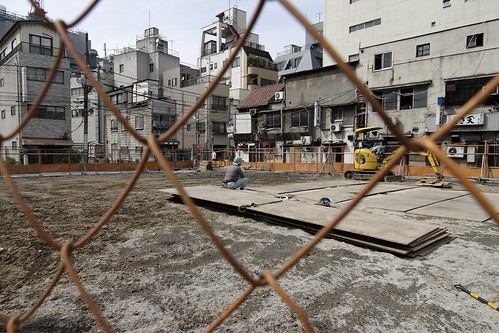
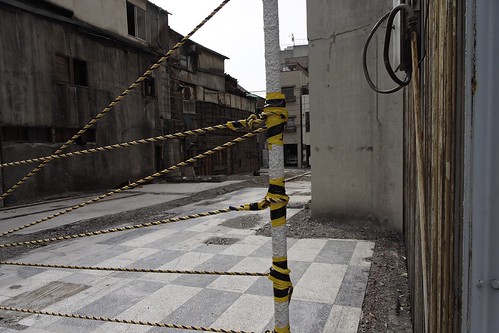
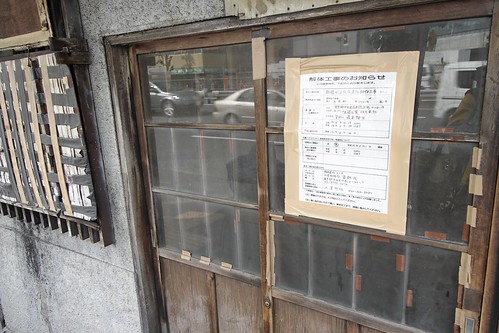
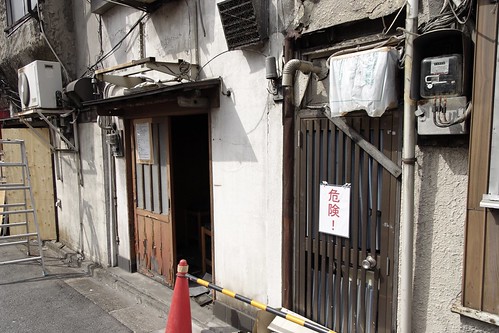
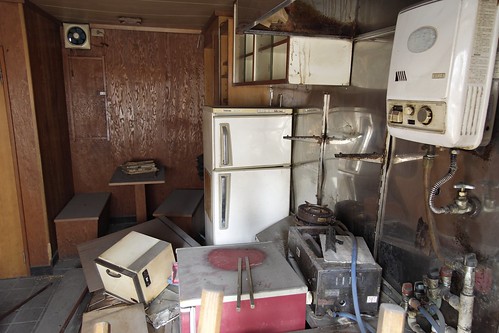
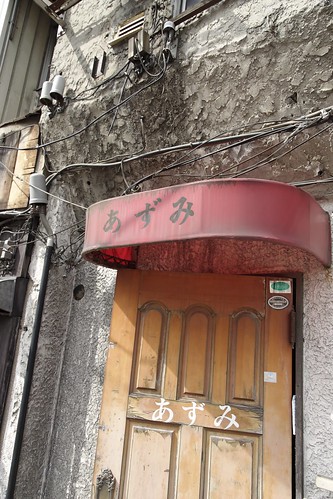
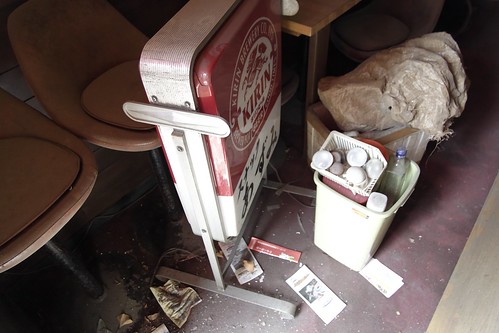
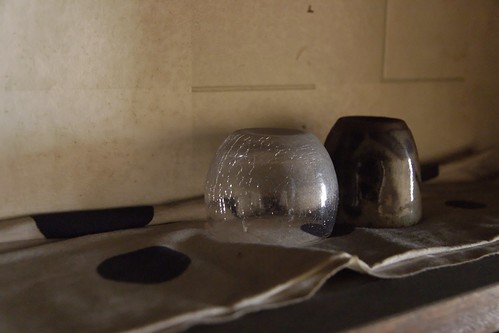
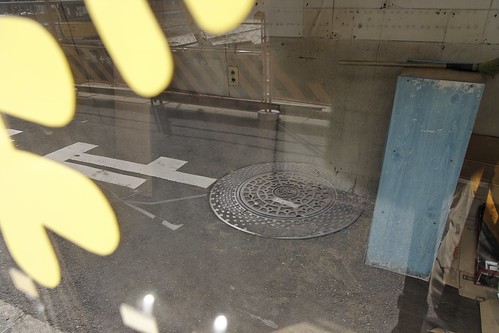
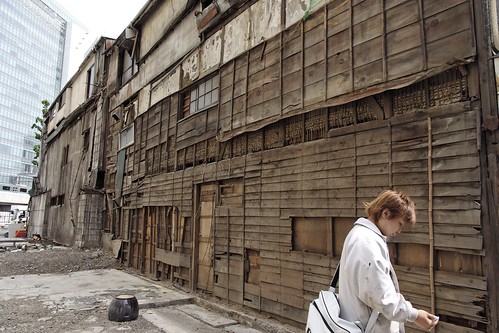
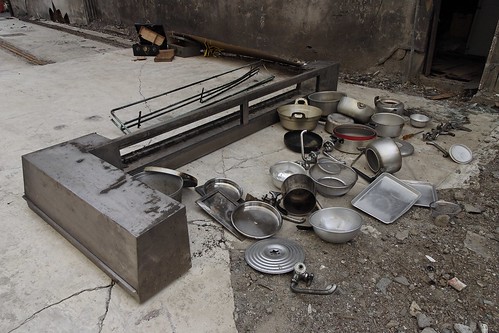

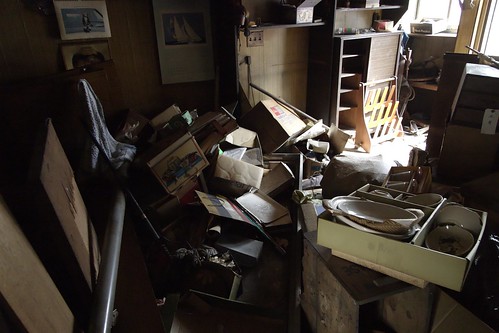
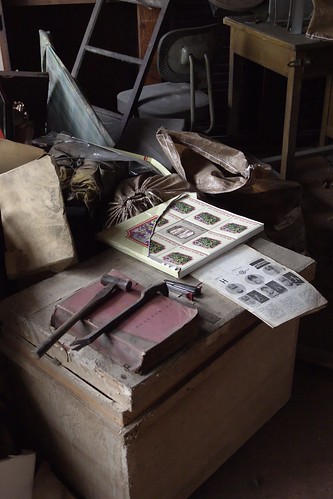
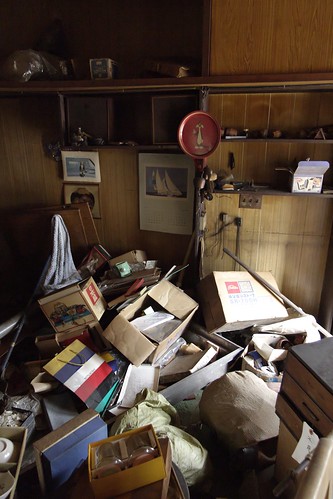
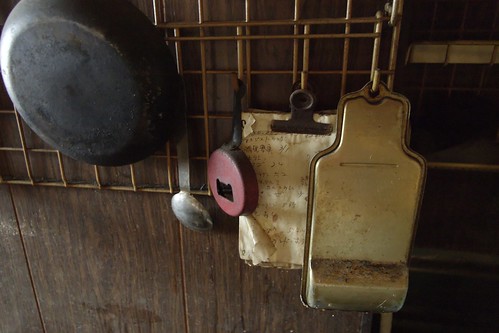
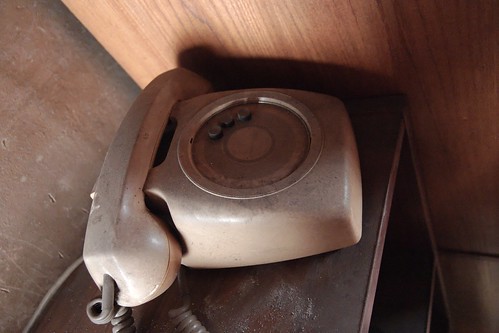
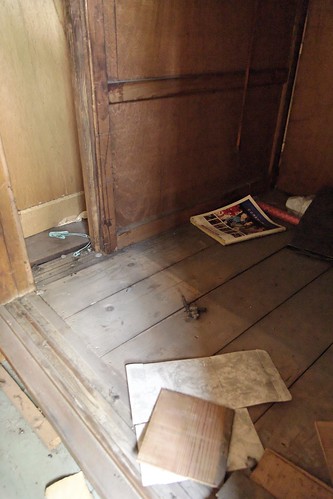
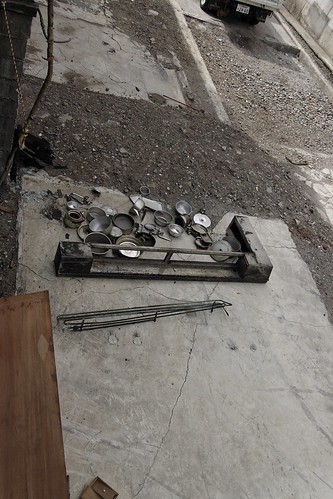
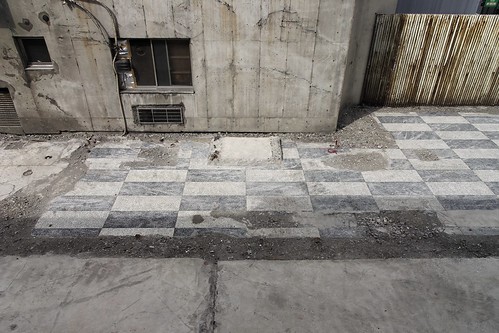
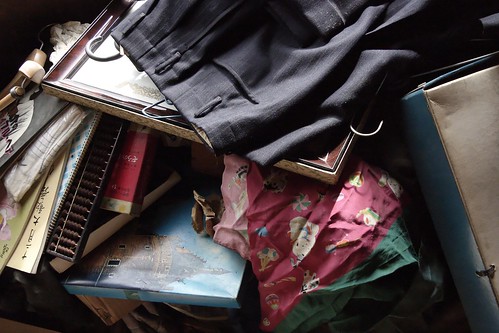

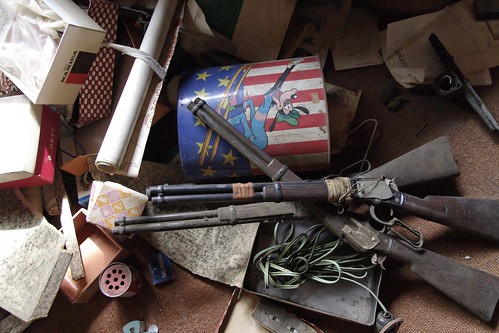
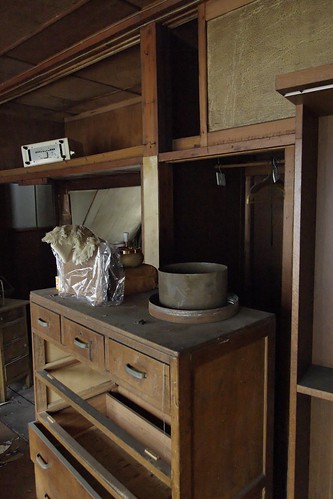
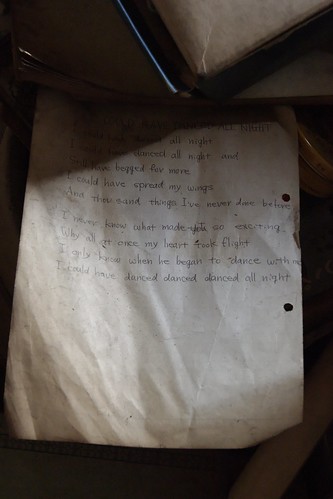
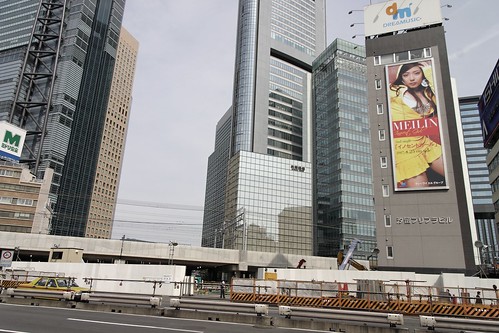
Very mysterious. I’m having Murakami Haruki flashbacks, now.
The stuff you’ve got here looks older than ’80s, which deepens the mystery. I could kind of imagine a sort of jiageya scenario, but most of that stuff looks more like it comes from the 60s….
I’ve seen very similar sights in abandoned houses where I live. One house next door had been empty for ten or twenty years, but was still full of remains like the ones you have photographed here. I think it’s just a good chance to junk the old crap and buuy new stuff. And saves throwing it out or paying someone to haul it away. And there is the chance that locals use it as a convenient tip….
One of the most interesting posts. Strangely, Kevin at bastish.net tells a very similar story of taking over an abandoned house. The old lady who had lived there had gone in to care and everything in her house was pretty much as she had left it – no-one had done anything to sort through her things. Makes you wonder if anyone at all paid any attention to the former occupants. Of course, I’m sure similar things happen here in the UK, but they’d surely be torched before very long.
Some how that picture reminds me of Oshii Mamoru’s “Patlabor,the movie”(the first one).
OK,the only reason we’ve met at Shinbashi was my intention of taking you two to Odaiba.I knew you guys were in Kyoto for long time so I avoided to take you to Yanaka,the old neighborhood just up of Ueno with lots of temples and Yanaka cemetary with the grave of the last Tokugawa Shogin.Maybe next time.
Jade.
You live in abandoned houses?
Bryce – sometimes it feels like it, especially my old apartment. Which was torn down when I left, and no, not because I ruined it beyond repair. But I was referring to the neighbourhood as “where I live” rather than the exact address. The operative words are “next door”….